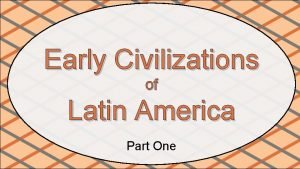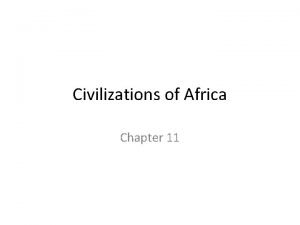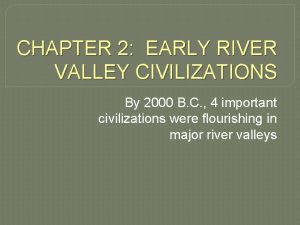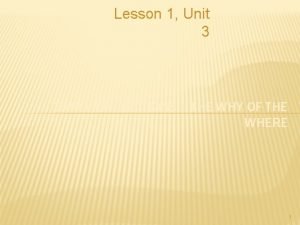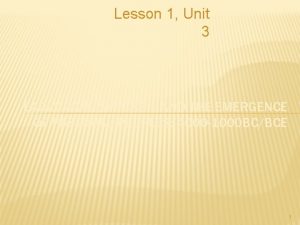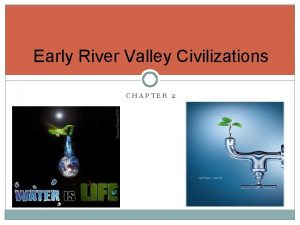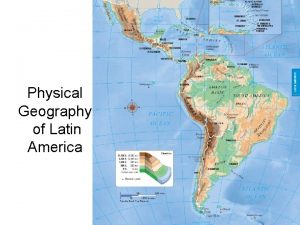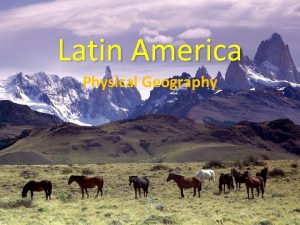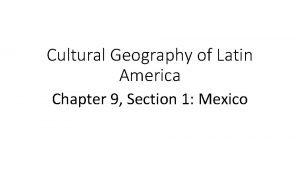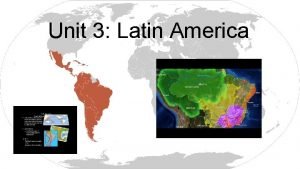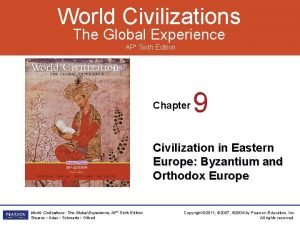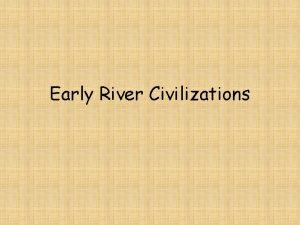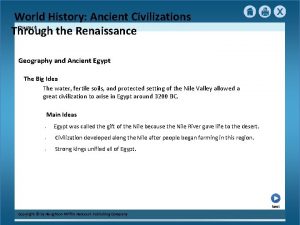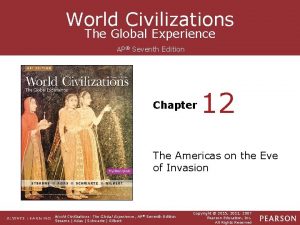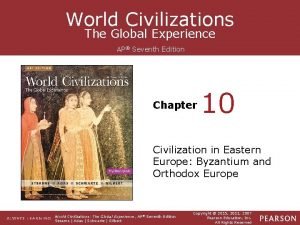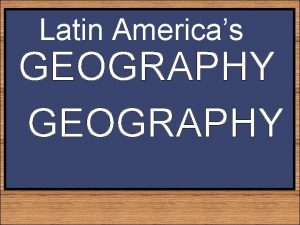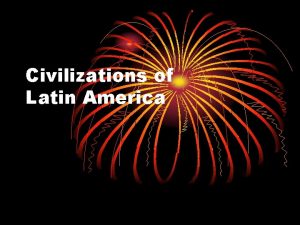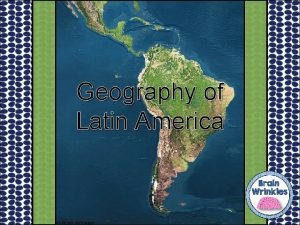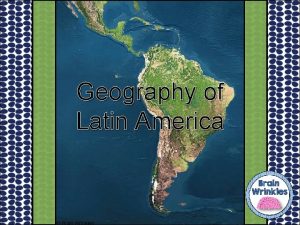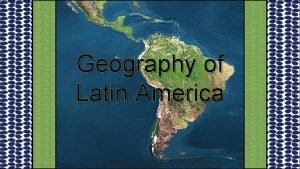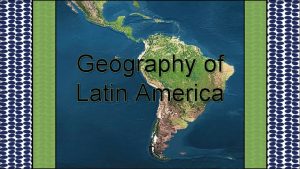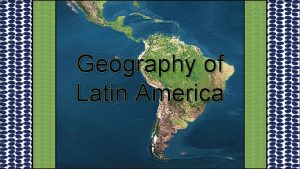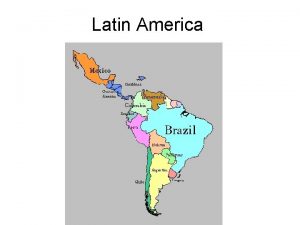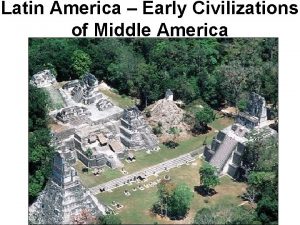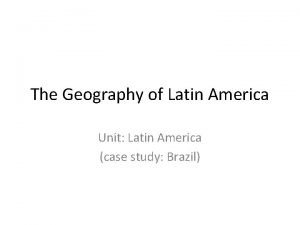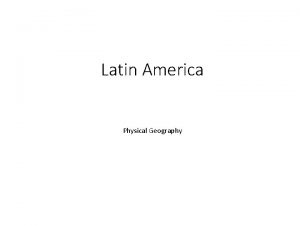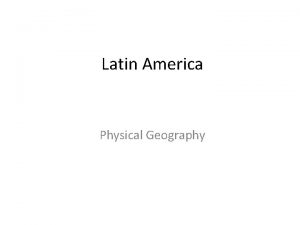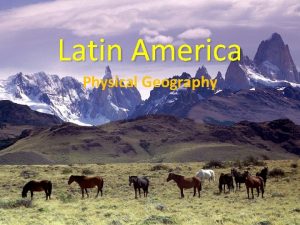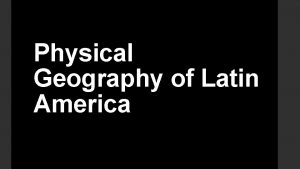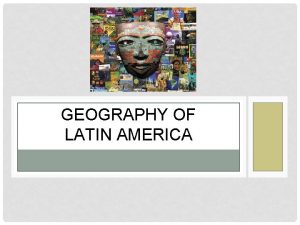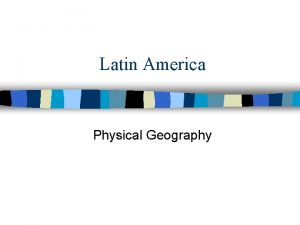World Geography Early Civilizations of Latin America ESSENTIAL
























- Slides: 24

World Geography Early Civilizations of Latin America ESSENTIAL QUESTION Which early Latin American civilization was most successful? LESSON 1 The Olmec and Maya LESSON 2 The Aztecs LESSON 3 Andean Civilizations 1 Copyright © by Houghton Mifflin Harcourt Publishing Company

World Geography LESSON 1 The Olmec and Maya The Big Idea Influenced by Olmec civilization, the Maya developed an advanced civilization that thrived in Mesoamerica from about 250 until the 900 s. Main Ideas • The Olmec were the first complex civilization in Mesoamerica and influenced other cultures. • Geography helped shape the lives of the early Maya. • During the Classic Age, the Maya built great cities linked by trade. • Maya culture included a strict social structure, a religion with many gods, and achievements in • science and the arts. The decline of Maya civilization began in the 900 s. 2 Copyright © by Houghton Mifflin Harcourt Publishing Company

World Geography Lesson 1 The Olmec Main Idea 1 The Olmec were the first complex civilization in Mesoamerica and influenced other cultures. • A civilization is an organized society within a specific area. – Often include large cities in which different social classes of people live – Writing, formal education, art, architecture, government • Around 1200 BC, the Olmec settled in what is now southern Mexico. • The area had good soil and climate for growing maize, or corn. 3 Copyright © by Houghton Mifflin Harcourt Publishing Company

World Geography Lesson 1 Main Idea 1 (continued) Olmec Life and Achievements • Most Olmec lived in small villages. • The Olmec made impressive buildings and sculptures. • The Olmec may have had one of the first writing systems in the Americas. Olmec Trade and Influence • There was a large trade network within Olmec civilization. • Olmec civilization ended around 400 BC, but later peoples built on their achievements. 4 Copyright © by Houghton Mifflin Harcourt Publishing Company

World Geography Lesson 1 Geography and the Early Maya Main Idea 2 Geography helped shape the lives of the early Maya. • The Maya civilization developed in the lowlands of what is now Guatemala. • Thick forests covered the area, so people had to clear the land for farming. • The Maya grew a variety of crops, including maize. • The forests also brought valuable resources, such as animals to use for food and trees for building materials. • The Maya lived in small villages that traded with each other for goods like cloth and materials like obsidian. • As trade grew, villages grew. Cities formed. 5 Copyright © by Houghton Mifflin Harcourt Publishing Company

World Geography Lesson 1 The Classic Age Main Idea 3 During the Classic Age, the Maya built great cities linked by trade. • The Maya civilization reached its height in a period called the Classic Age. • Each Maya city had its own government and king. • The Maya cities in the highlands traded with those in the lowlands. • People could get things they did not have nearby. • People traded items such as cacao beans, obsidian, jade, cotton, and supplies for construction. • Maya constructed temples to honor local kings. • For example, in Palenque, the king Pacal had a temple built. • Maya built canals, plazas, and ball courts. • Volcanic activity influenced Maya farming and trade. 6 Copyright © by Houghton Mifflin Harcourt Publishing Company

World Geography Lesson 1 Maya Culture Main Idea 4 Maya culture included a strict social structure, a religion with many gods, and achievements in science and the arts. Social Structure • The king held the highest position in Maya society. He was believed to be related to the • • gods. Together with the king, the priests, merchants, and noble warriors held all the power in Maya society. Most Maya belonged to the lower class, made up of farming families who lived outside the cities. Lower class Maya also had to pay rulers tribute with crops or goods and help construct buildings. Slaves carried trade goods, farmed, and were household servants. 7 Copyright © by Houghton Mifflin Harcourt Publishing Company

World Geography Lesson 1 Main Idea 4 (continued) Religion • Maya worshiped many gods who the Maya believed controlled a different part of daily life. • Gods could be helpful or harmful, so the Maya tried to please the gods. • The Maya believed the gods needed blood to prevent disasters, so they offered their blood from piercings or sometimes used human sacrifices. Achievements • Made advances in science • Built observatories to study the sky and stars • Created an accurate calendar • Used a symbol for zero • Developed a writing system • Created art and architecture 8 Copyright © by Houghton Mifflin Harcourt Publishing Company

World Geography Lesson 1 Decline of Maya Civilization Main Idea 5 The decline of Maya civilization began in the 900 s. • Historians are not sure why Maya civilization collapsed. • Most scholars agree that it was a combination of causes. • One theory is that people may have rebelled against the kings, who demanded too much of them. • Another theory is that increased warfare over food may have destroyed the Maya. • A long period of droughts may have played a role. • Decline happened gradually and by the 1500 s, Maya power had faded. 9 Copyright © by Houghton Mifflin Harcourt Publishing Company

World Geography LESSON 2 The Aztecs The Big Idea The strong Aztec Empire, founded in central Mexico in 1325, lasted until the Spanish conquest in 1521. Main Ideas • The Aztecs built a rich and powerful empire in central Mexico. • Social structure, religion, and warfare shaped life in the empire. • Hernán Cortés conquered the Aztec Empire in 1521. 10 Copyright © by Houghton Mifflin Harcourt Publishing Company

World Geography Lesson 2 The Aztecs Build an Empire Main Idea 1 The Aztecs built a rich and powerful empire in central Mexico. • The first Aztecs were farmers, but when they arrived in Central America, all the good farmland was taken. • They settled on a swampy island in the middle of Lake Texcoco, built a capital, and started to conquer nearby towns. • War was the key factor in the Aztecs’ rise to power. • War, tribute and trade made the Aztec Empire strong and rich. • Its greatness was visible in its capital Tenochtitlán. • To build Tenochtitlán, the capital of the empire, the Aztecs had to overcome many challenges. It was built on an island in the middle of a lake. • Canals, causeways, and chinampas, or floating islands, helped solve the problems. 11 Copyright © by Houghton Mifflin Harcourt Publishing Company

World Geography Lesson 2 Life in the Empire Main Idea 2 Social structure, religion, and warfare shaped life in the empire. Aztec Society • The king was the most powerful person in Aztec society and was in charge of law, trade, • • • tribute, and warfare. The nobles helped the king as tax collectors and judges and performed other jobs as well. They passed their titles down from father to son. Below the nobles was a class of warriors and priests. Merchants and artisans were the next level of Aztec society. The lower class, farmers and laborers, made up the majority of the population. Slaves were the bottom of the social hierarchy. 12 Copyright © by Houghton Mifflin Harcourt Publishing Company

World Geography Lesson 2 Main Idea 2 (continued) Religion and Warfare • Aztecs worshiped many gods. • They believed the gods controlled nature and human activities. • They made sacrifices of humans to the gods. • They fought battles to get people for human sacrifice. Cultural Achievements • The Aztecs created pyramids, statues, jewelry, masks, and colorful cloth. • They also studied astronomy and created a calendar. • They had a strong oral tradition as well as written records. 13 Copyright © by Houghton Mifflin Harcourt Publishing Company

World Geography Lesson 2 Cortés Conquers the Aztecs Main Idea 3 Hernán Cortés conquered the Aztec Empire in 1521. • A small group of conquistadors led by Hernán Cortés reached Mexico in 1519. • The leader of the Aztecs, Moctezuma II, believed that Cortés was a god. • Cortés took Moctezuma prisoner. The Aztecs attacked Cortés and his men. The Spanish were driven out, but Moctezuma was killed. • Cortés returned with many allies from other peoples in the region, and in 1521 they defeated the Aztecs and ended their empire. • The Spanish had better weapons than the Aztecs. • The Spanish had brought diseases to the Americas. These diseases killed thousands of Aztecs. • Diseases, plants, and animals brought by the conquistadors left a lasting impact on the Americas. • Much of the information we have about the Aztecs and Mayas is filtered through the writings of the Spanish. 14 Copyright © by Houghton Mifflin Harcourt Publishing Company

World Geography LESSON 3 Andean Civilizations The Big Idea After many smaller civilizations rose and fell, the Inca controlled a huge empire in South America, but it was conquered by the Spanish. Main Ideas • Prior to the Inca Empire, several civilizations grew in the Andes and along the Pacific coast of South • • • America. The Inca created an empire with a strong central government in South America. Life in the Inca Empire was influenced by social structure, religion, and the Inca’s cultural achievements. Francisco Pizarro conquered the Inca and took control of the region in 1537. 15 Copyright © by Houghton Mifflin Harcourt Publishing Company

World Geography Lesson 3 Geography and Early Andean Civilizations Main Idea 1 Prior to the Inca Empire, several civilizations grew in the Andes and along the Pacific coast of South America. The Geography of the Andes • The Andes Mountains run along the western side of South America. • High plains, or altiplano, sit between mountain ridges. • A desert runs along the Pacific coastline. 16 Copyright © by Houghton Mifflin Harcourt Publishing Company

World Geography Lesson 3 Main Idea 1 (continued) Early Societies • Chavín culture: 900 to 200 BC; grew maize and potatoes; known for textiles, carved stone, and pottery • Moche or Mochica: AD 1– 800; made pyramids out of adobe; religion involved human sacrifice and blood drinking; created pottery and metalwork; drought may have contributed to decline • Nazca: 200 BC to AD 600; used irrigation technology to farm dry areas; created large figures in the desert; weakened by drought, then conquered • Chimú: conquered by Inca around 1460; created roads, irrigation systems, and a large capital; made complex metalwork and textiles; strong influence on Inca culture and technology 17 Copyright © by Houghton Mifflin Harcourt Publishing Company

World Geography Lesson 3 The Inca Create an Empire Main Idea 2 The Inca created an empire with a strong central government in South America. • The early Inca began as a small tribe in the Andes Mountains. • A ruler named Pachacuti led the Inca to expand their territory through agreements with, or conquests of, other tribes. • The capital of the empire was in Cuzco. • Later Inca rulers continued to expand their territory. By the 1500 s the Inca Empire was huge. 18 Copyright © by Houghton Mifflin Harcourt Publishing Company

World Geography Lesson 3 Main Idea 2 (continued) Central Rule • Pachacuti wanted to limit the power of conquered people. • They made the conquered leaders move out of their villages and replacing them with leaders who were loyal to the Inca government. • The Inca made the children of the conquered leaders come to the Inca capital to learn about Inca ways. • The Inca established an official language, Quechua. 19 Copyright © by Houghton Mifflin Harcourt Publishing Company

World Geography Lesson 3 Main Idea 2 (continued) A Well-Organized Economy • The central government controlled the economy and had people pay a tax with their labor. • This system was called the mita. • There were no markets or merchants. Instead, the government would distribute goods. Leftover goods were stored in the capital for emergencies. 20 Copyright © by Houghton Mifflin Harcourt Publishing Company

World Geography Lesson 3 Life in the Inca Empire Main Idea 3 Life in the Inca Empire was influenced by social structure, religion, and the Incas’ cultural achievements. Social Divisions Religion • There were two classes in Inca society • The Inca Empire had an official religion. • The emperor, priests, and government officials made up the Inca upper class. • The Inca believed their kings were related to the sun god. • Upper-class families had many privileges, such as stone houses and the best clothes. They did not pay the labor tax. • The Inca rarely sacrificed humans. Instead, they sacrificed llamas, cloth, or food. • Elements of Inca religion can still be found in rural areas of the Andes. • The lower class was made up of farmers, artisans, and servants. There were no slaves in Inca society. 21 Copyright © by Houghton Mifflin Harcourt Publishing Company

World Geography Lesson 3 Main Idea 3 (continued) Achievements • The Inca were known for their massive buildings and forts made of masonry, or stone blocks. Blocks were cut so precisely that even today it is nearly impossible to fit a knife blade between the stones. • The Inca also built a system of roads that were so well built that some still exist today. • Inca artisans made jewelry of silver and gold. • Inca artists also made brightly colored textiles. • No written language, but quipus were a system of knots that kept records. • Literature was made up of storytelling and songs. The Inca also passed down their songs, dances, and religious practices. 22 Copyright © by Houghton Mifflin Harcourt Publishing Company

World Geography Lesson 3 Pizarro Conquers the Inca Main Idea 4 Francisco Pizarro conquered the Inca and took control of the region in 1537. • A civil war began in the Inca Empire between the two sons of the king, Atahualpa and Huáscar. • Atahualpa eventually won the war, but the infighting had weakened the empire. • On his way to be crowned, Atahualpa was captured by conquistadors led by Francisco Pizarro. • The Inca tried to free Atahualpa by offering the Spanish a roomful of gold and silver, but the Spanish killed Atahualpa anyway. • The Spanish defeated the last of the Inca, and the empire fell in 1537. 23 Copyright © by Houghton Mifflin Harcourt Publishing Company

World Geography Lesson 3 Main Idea 4 • (continued) The causes for the fall of the Inca Empire were similar to those of the Aztec Empire. – Internal problems within the empire – Leaders were captured. – Guns and horses gave the Spanish an advantage. – Disease weakened the native people. • Elements of Inca culture remain important in the region today. 24 Copyright © by Houghton Mifflin Harcourt Publishing Company
 Why is latin america called latin america
Why is latin america called latin america Inca diorama
Inca diorama Lesson 1 early civilizations
Lesson 1 early civilizations Chapter 11 section 1 early civilizations of africa
Chapter 11 section 1 early civilizations of africa Cahokia apush definition
Cahokia apush definition River valley civilizations def
River valley civilizations def Geographic luck definition
Geographic luck definition Lesson 1 early civilizations
Lesson 1 early civilizations Chapter 2 early river valley civilizations
Chapter 2 early river valley civilizations Middle america
Middle america Latin america's geography cloze notes 1
Latin america's geography cloze notes 1 Physical geography of latin america
Physical geography of latin america Vocabulary activity 9 cultural geography of latin america
Vocabulary activity 9 cultural geography of latin america Latin america's geography cloze notes 1
Latin america's geography cloze notes 1 Chapter 8: the physical geography of latin america answers
Chapter 8: the physical geography of latin america answers Unit 3 latin america
Unit 3 latin america Rap of the map of the us
Rap of the map of the us World civilizations the global experience ap edition
World civilizations the global experience ap edition World civilizations the global experience 7th edition
World civilizations the global experience 7th edition Longest river in the world
Longest river in the world Ancient civilizations through the renaissance
Ancient civilizations through the renaissance World civilizations the global experience 7th edition
World civilizations the global experience 7th edition World civilizations the global experience 7th edition
World civilizations the global experience 7th edition Plamatic acid
Plamatic acid Early essential newborn care
Early essential newborn care

